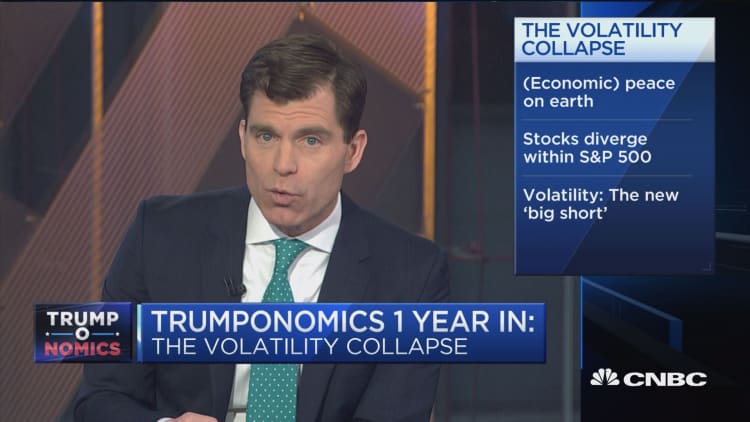
It's been a year since consensus opinion was punctured by a Donald Trump electoral win and a market rally that deflated Wall Street oddsmakers' view that a Clinton loss would slam stocks.
Yet even the small minority expecting a Trump victory and positive market response mostly thought heightened market volatility would be a feature of an establishment-deriding president set on raising the economic metabolism and waging trade wars.
Quite the opposite. The past 12 months have seen one of the most profound and prolonged declines in market volatility on record.
Tuesday was the 44th-straight trading day without even a half-percent drop in the — the longest such streak since 1968. The index is also on one of its longest runs without a 3 or 5 percent dip in decades.
The CBOE S&P 500 volatility index, or VIX, has collapsed to below 10 from a reading of 22 a day before the 2016 election. The VIX, which tracks the "implied volatility" embedded in index-option prices, had its lowest average reading ever in the third quarter of this year, and slipped for three-straight quarters for the first time since 2011.
So far in the fourth quarter, it has closed in single-digits — a once-rare occurrence — 12 out of 27 trading days. For the first time ever, the Chicago Board Options Exchange listed VIX options with an 8.50 strike price, to accommodate traders wishing to play further volatility slippage.
What explains this striking and unexpected outbreak of calm?
(Economic) Peace on Earth
This year has featured an unusual degree of harmonious, measured economic growth across the world. All 35 countries in the OECD are growing, and the spread among their growth rates has been the narrowest in 50 years. Meantime, central bank policies remain quite accommodating.
As a result, corporate earnings are growing respectably, and credit markets are firm. Measures of financial conditions are the strongest (meaning the loosest) they've been since at least 2007.
BlackRock global investment strategist Richard Turnill notes that extended periods of low market volatility tend "to overlap with periods of low macroeconomic vol." This was the case in the mid-2000s and the mid-'90s as well, not to mention most of the 1950s.
The lack of much transformative economic policy coming from Washington so far neatly fits in with this pattern. The market tends to thrive on gridlock, which might be viewed as "low policy volatility."
Wars of words between the White House and Congress, a special prosecutor, bellicose POTUS tweets against North Korea — all make good headlines and may leave an impression of disorder. But these are not things that markets usually, or should, seek to price into equity values.
Volatility regime shifts
Markets tend to alternate between long stretches of calm — often lasting years — interrupted by briefer bouts of elevated volatility. The 2016 election came after more than a year of serial volatility eruptions: China currency devaluation, oil crash, earnings recession and Brexit kept markets in an anxious state — and they came just before the election.
Prolonged tension release tends to follow once these fevers break. Note that the day-to-day market swings have been minimal, with a record dearth of 1 percent moves. This means the VIX is not "too low," but mostly just reflects the sleepy condition of the market itself.
Stocks going their own way
Another big force smothering index-level volatility: the huge variation of stock and sector performance within the index. Correlation among S&P 500 stocks has been plumbing record lows, as the market ruthlessly separates winners from losers.
Coming into this week, with the S&P 500 up more than 15 percent year to date, almost 30 percent of S&P 500 member stocks were down this year, while close to 4 in 10 stocks in the indexes were up more than 20 percent. Call this a bifurcated index, a selective tape, a stockpicker's market — however it's described, these offsetting moves have the mathematical effect of dampening index-level moves.
The 'short vol' trade
The volatility crash, naturally, has drawn investors who want to play the trend. This has been possible in recent years through exchange-traded notes that trade VIX futures to profit from low or falling volatility. The largest of these, VelocityShares Daily Inverse VIX Short-Term ETN (XIV) makes money (to oversimplify) when VIX futures trade higher than the VIX itself.
Institutional investors have also incorporated "short vol" strategies as a way to pull income out of a slowly rising, expensive stock market.
For years, the more popular trade was to buy instruments that rose with the VIX as a hedge against market turmoil. The largest is iPath S&P 500 VIX Short-Term Futures (VXX). Yet currently, the 12 largest "inverse volatility" ETNs, which bet on low volatility, have $2.5 billion in collective assets under management, two-thirds more than the $1.5 billion in "long vol" funds such as VXX.
Many have argued short vol is a crowded trade that will lead to a messy unwinding whenever markets get jumpy again. It's far from clear if this is so; there are structural reasons related to futures pricing patterns that XIV will have an upside bias over time, while VXX will erode in value.
Certainly, a big, collective short vol position could exacerbate moves or lead to unexpected chain reactions in a market slide. But the key is that the market's character itself will need to change for such a moment to arise.
That probably would require the market sniffing out rising inflation risk, a quick pickup in inflation, a rapidly changing outlook for Fed policy or some kind of "financial accident" creating a rupture in capital markets the way the Chinese currency devaluation did in 2015. Maybe one of these will be the story of 2018, in which case the volatility that went missing after the last election might return in time for the midterm vote next November.


